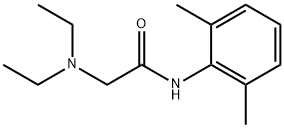137-58-6

SAFETY INFORMATION
| Signal word | Warning |
|---|---|
| Pictogram(s) |
 Exclamation Mark Irritant GHS07 |
| GHS Hazard Statements |
H302:Acute toxicity,oral |
PRODUCT INTRODUCTION
Description
Lidocaine is the monocarboxylic acid amide resulting from the formal condensation of N, N-diethylglycine with 2,6-dimethylaniline. It is a tertiary amine compound and a member of benzenes. It has a role as a local anesthetic, an anti-arrhythmia drug, an environmental contaminant, a xenobiotic, and a drug allergen. As an anesthetic of the amide group, it is indicated for the production of local or regional anesthesia by infiltration techniques such as percutaneous injection and intravenous regional anesthesia by peripheral nerve block techniques such as brachial plexus and intercostal and by central neural techniques such as lumbar and caudal epidural blocks.
Uses
Lidocaine is commonly used for local anesthesia, often combined with epinephrine (which acts as a vasopressor and extends its duration of action at a site by opposing the local vasodilatory effects of lidocaine). It can be used intravenously during advanced airway management as an adjuvant to tracheal intubation, obtunding the hypertensive response to laryngoscopy and potentially reducing the incidence of myalgia and hyperkalemia when succinylcholine is given. Lidocaine is a class Ib antiarrhythmic agent on the Vaughan-Williams classification, and its use is indicated in the management of acute ventricular tachydysrhythmias. It also has roles as an adjuvant analgesic in managing acute and chronic pain.
Side effects
The severe side effects of lidocaine include Cardiac arrest, Abnormal heartbeat, Methemoglobinemia, Seizures, Severe allergic reactions (anaphylaxis), and Malignant hyperthermia.
Mechanism of action
The principal mechanism of action of lidocaine as a local anesthetic is through the blockade of voltage-gated sodium channels (VGSCs), leading to a reversible block of action potential propagation. Like with all local anesthetics, only the un-ionized form of the drug (i.e., the free base form) is able to permeate the lipophilic cell membranes. Intracellularly, the ionized form blocks sodium channels by binding to Segment 6 of Domain 4 of the α-subunit of the ion channel. When the local anesthetic is bound to the sodium channel, the influx of Na+ is interrupted, and action potential generation and propagation are inhibited. Local anesthetics bind preferably to the open or inactivated state of VGSCs; thus, the onset of local anesthetic action is faster in rapidly firing neurons.
